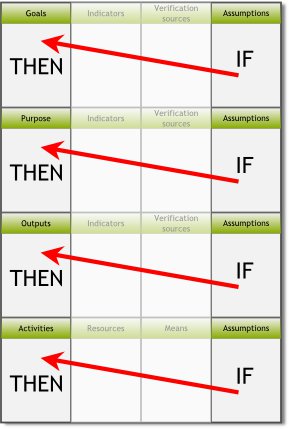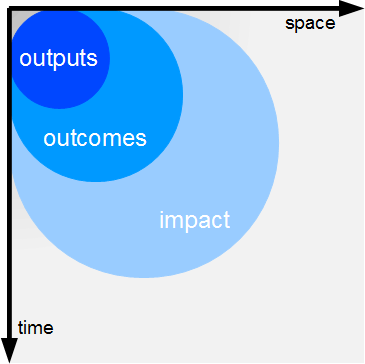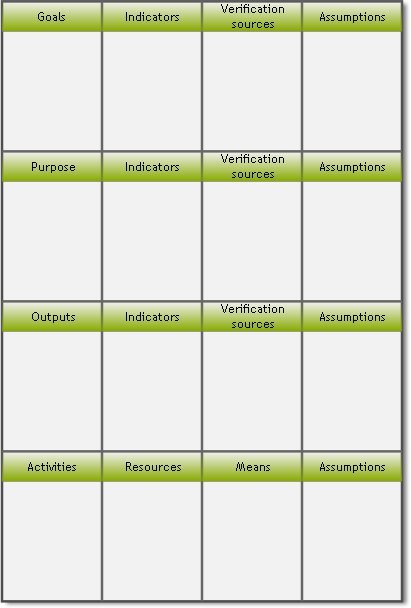Project design
The project design phase has two main parts:
- Identification and planning with the stakeholders and beneficiaries
- Deciding on the intervention logic and developing the logical framework and the project documentation
Identification and planning
During this first phase, problems and issues are identified, as well as possible ways to tackle them (strategies for solutions). Then the best intervention strategy is selected, which will be the basis for the project plan.
Usually the organisation that takes the initiative will have a basic idea of the problem it wants to tackle, the future intervention area and possible stakeholders. In this phase, these preliminary ideas are put to the test through participatory methods. But first you need to find people that want to help you with the identification of the problems and needs.
Step 1: Stakeholder analysis and identification of beneficiaries

There are different categories of stakeholders that you could involve in the project’s design. In first instance, the potential beneficiaries of course: these can be local farmers or entrepreneurs; people that make use of medical facilities; villagers; local business people; women; young people; members of minority groups… It all depends on the type of project and the local situation. In addition, you can talk with local authorities, local NGOs, village councils (village elders), ministry delegates and so on.
For each group you can describe:
- To what categories they belong
- What their number is
- What their socio-economic situation is and any other relevant characteristics
- What their potential is to contribute to a solution for the selected problem(s)
Step 2: Identification of problems and needs
 During this step, a problematic situation is analysed with the different stakeholders, including the (potential) beneficiaries of the project. Usually a method like the problem tree analysis or a fishbone analysis is used. Once the central problem is identified, the participants to the workshop can identify its root-causes. The following step is to describe the negative consequences of the problem and select the most important ones.
During this step, a problematic situation is analysed with the different stakeholders, including the (potential) beneficiaries of the project. Usually a method like the problem tree analysis or a fishbone analysis is used. Once the central problem is identified, the participants to the workshop can identify its root-causes. The following step is to describe the negative consequences of the problem and select the most important ones.
The problem tree then can be turned into a solutions tree, which will probably contain different ways of approaching the problem. Depending on the possibilities and capacities of the different partners and of the beneficiaries, the best approach or strategy to dealing with the central problem can be identified.
Step 3: Determining the Performance Framework (PF)
 The Performance Framework (not to be confused with the Performance Measurement Framework) describes the intervention logic of the project. It describes how what we invest and what we do will lead to tangible results.
The Performance Framework (not to be confused with the Performance Measurement Framework) describes the intervention logic of the project. It describes how what we invest and what we do will lead to tangible results.
With the information from the solution tree analysis (or another method), the basic elements of the project can be identified:
- What is the purpose of the project (the central problem in the problem/solution tree analysis)?
- What results do we expect?
- Who will benefit from the project?
- What is the best approach (strategy)?
The next step is to determine the results chain:

Outputs, effects and impact have to be described in such a way that they are clear for everyone and can’t be misinterpreted. It’s best to avoid overly complex formulations and complex concepts that may be interpreted differently in various contexts (for instance: ‘gender equality’ or ‘durability’). It’s better to explain what you mean by those fancy concepts in as plain a language as possible.
The performance Framework will later be used to fill out the left column of the logical framework.
Step 4: Finding indicators and developing the Performance Measurement Framework

The Performance Measurement Framework (PMF) is the next step after the Performance Framework. For each result that we expect for our project, we’ll identify indicators, ways to verify the information, ways to collect the information, the frequency at which the information is gathered and who is responsible for gathering that information.
Indicators
For each level in the results chain (outputs – effects – impact), indicators have to be found. ‘Indicators’ does not necessarily equal ‘hard numbers’. However for RBM it is important to find indicators that are clear, concise and not up for interpretation. It’s a good idea to list as many indicators as you can to start with, and then select the most pertinent ones. You want these indicators to be:
- Valid: this means that the indicator measures the result
- Sensitive: when the result changes, does the indicator change with it?
- Reliable: does the indicator give the same value over time or when observed by different observers?
- Simple: how difficult is it to gather data and to process it?
- Usable: can we use that information to take decisions and to learn?
- Affordable: do we have the resources to gather the information?
Finding indicators is again a participatory exercise. At the very least people have to be able to be feedback to the indicators you suggest. It’s a good idea to test your draft list of indicators in real-world conditions.
Outreach indicators
Apart from the ‘classic’ output, effect and impact indicators, RBM also uses outreach indicators. Outreach indicators say something about the people that you reach. Very often, project indicators only talk about things like production, quality improvement, availability of services, training and capacities, etc. The human dimension – in other words the very reason for doing a development project in the first place – is totally left out.
RBM pushes you to reflect about outreach on all three levels of the results chain. The higher up the chain, the more difficult it becomes to accurately assess how many people the project will reach. Here are some questions to help you identify the outreach:
- Who are the direct and indirect beneficiaries at each level of the results chain?
- How many people will (ultimately) benefit from the project? How many men and how many women will benefit? What age groups will benefit? How many people from rural or urban areas will be involved?
- What are the main characteristics of these people? What is their social, economic, cultural… situation. What is their health situation? How well are they educated? Are their rights respected? Do they live in fear of violence or conflict? And so on…
- What will the project do for these groups? What will the positive and negative results be?
Verification sources
Where can you find the information for your indicators? You can make use of:
- direct observation
- information from various official reports and statistics
- interviews
- pictures
- satellite images
- …
In some cases it may be interesting to have various sources of information that you can compare to each other (triangulation). Or you may need to combine different sources of information to get a complete picture.
Another question is how you will practically gather the information: using registration forms or questionnaires; registering it in a database or a spreadsheet; doing surveys… You must also decide on how regularly you will gather the information. And last but not least whose responsibility it is to gather what information.
Who is responsible for what?
There is more than just deciding on who is responsible for gathering certain pieces of information. It has to be clearly established how the responsibility for achieving the results is shared.
- Who is responsible for what activities and for what tangible outputs?
- How will the resources be distributed and who will manage what resources?
- How will the partners contribute to the project in terms of human resources, funding, time
- etc.
The Performance Measurement Framework (PMF)
With all this information, the PMF can be established:
|
|
Indicators |
Verification sources |
Collection method |
Frequency |
Responsible |
|
Impact |
|
|
|
|
|
|
Effects |
|
|
|
|
|
|
Outputs |
|
|
|
|
|
|
Activities |
|
|
|
|
|
|
Outreach |
|
|
|
|
|
|
Inputs |
|
|
|
|
|
The outputs and activities matrix
The O&A matrix is a planning tool that can be used to elaborate the more practical side of the project. For each output and effect it allows you to specify what activities are necessary, what resources (inputs) you will need and who will be responsible for that activity.
|
|
Activities |
Resources |
Responsible party |
|
Effect 1 |
|
|
|
|
Effect 2 |
|
|
|
|
Output 1 |
|
|
|
|
Output 2 |
|
|
|
Step 5: Identifying assumptions and analysing risk factors

When you take a closer look at the results chain, you will probably see that the cause and effect relations between activities and outputs, between outputs and effects and between outputs and impact are conditional. Basically, if all holds well we can expect that we’ll get the results that we want at the end. This means that we (implicitly) make a number of assumptions. What does it mean ‘if all goes well’?

RBM makes a distinction between assumptions, which are positive conditions, and risks that are negative factors. Both assumptions and risks can be internal or external factors. Internal factors are the things we have under control: the capacities of our staff, our management capacity, delegation of authority, etc. External factors are influences from the environment on our project.
There are different types of risks and assumptions:
- Operational risks are linked to the activities, the availability of resources, logistical problems, etc.
- Objectives risks and assumptions have a direct influence on whether we will be able to achieve our results.
- Financial risks
- Reputation risks
Risks can have varying degrees of impact on our project. The influence of some risks will be negligible, or else they may be a nuisance but nothing we can’t handle. In other cases they may have a severe influence on whether we will be able to realise our objectives. In the worst case scenario, we may be forced to stop the project altogether.
Another factor we have to assess is what the chance is realistically that a risk will materialise during the project. The combination of the impact that a risk might have and its likelihood helps us to assess the situation and take (preventive) action. If a risk has low impact and is not likely, it’s really not worth mentioning in your logframe. High impact risks with low likelihood still have to be monitored. And when a risk really threatens the project and is very likely, it’s probably not worth starting the project in the first place.
Merely identifying the risks is not enough: it’s also important to reflect on what you will do if or when the risk occurs:
- Are you going to try to avoid the consequences or the risk altogether (for instance through disaster risk reduction)?
- Are you able to deal with the consequences?
- Will you be able to transfer the burden to someone else (an insurance company for instance)?
- Or will you do your best to mitigate the consequence as much as possible?
The Risk Register
The Risk Register is a tool to identify and monitor risks over the course of the project. It resembles the PMF and lists the risks, the risk indicators, information sources, methods to collect information, the frequency at which the information will be collected and who is responsible for this information gathering.
|
Risks |
Indicators |
Information sources |
Data collection methods |
Frequency |
Responsible party |
|
|
|
|
|
|
|
Step 6: Activities, resources and responsibilities

At this point, it is time to take a look at the activities from a very practical point of view:
- When will the activity start and how long will it take? Does the activity follow another one? Does it depend on that previous activity (does it need the outputs of that previous activity as inputs)?
- What inputs (resources) are needed: people, knowledge/information, money, equipment and tools, natural resources, energy, space, logistics…
- How much preparation time is needed? Who is involved in preparation?
- If the activity is complex, a specific budget may have to be made up.
- Who is involved? Who is responsible for managing the activity? Who will execute the activity (one of the partners, or maybe a subcontractor or service provider)? Who can give support? Who has to be consulted beforehand (authorities, beneficiaries, management…)? Who needs to be informed? This series of questions is called RASCI, short for Responsible, Action, Support, Consulted, Informed (although other flavours also exist, such as RACI or RASI).
- What methods or procedures have to be followed?
- What tangible outputs are expected (reports, goods, trained people….)?
- Does the activity have to be repeated over time? How many times/how regular?
- How will the follow-up be organised? How much follow-up time is needed? Who is responsible for follow-up?
For simple activities, you may not have to go through this whole list of questions, but complex activities need to be planned and budgeted in some detail.
Deciding on the intervention logic (project logic)
The intervention logic is the cause-and-effect chain or results chain that’s been identified in the Performance Framework:
- You gather the necessary resources (human resources, materials, equipment) and funds
- With the resources, you can organise the activities
- The activities produce outputs: goods, services, knowledge, information, etc. These are the immediate results.
- When these outputs are used, they lead to effects or intermediate results.
- The effects contribute to the final results, or impact.
This information is presented in the logical framework (first column, except for the resources).
Note that compared to the ‘classic’ logical framework as it is used in LFA and PCM, there is a dimension of time in the intervention logic of RBM, as well as a spatial dimension. We immediately get the outputs as a consequence of the activities. But it takes time for the effects to materialise (near the end of the project or maybe even after it) and the impact will only be visible after a long time (sometimes years or even decades after the project). The outputs will be used directly by the people involved in the project, while the effects are generally felt by those people and their immediate surroundings (family, clan, village). The impact on the other hand may be visible in a widespread area (region, country, internationally).

Step 7: Developing the logical framework

Now it’s time to bring together all the information that you’ve gathered so far into the logical framework matrix:
- The first (left) column contains the intervention logic.
- The second column contains the indicators
- The third column contains the verification sources
- The fourth column contains the assumptions/risks.

Once you’ve filled out the basic ideas, it’s time to worry about formulation. Make sure that your results are clear and not too overly complex. It’s important that they are unambiguous – meaning that they are understood the same way by everyone involved in the project. Avoid overly complex concepts such as ‘gender neutral’, ‘globalisation’, ‘sustainable’ that can be interpreted in many different ways. If you need such concepts, make sure that you specify them in your logframe and/or explain them somewhere.
It’s best to make sure that your results are formulated in a SMART way:
- Specific: What exactly will change? Where? For whom (who will benefit)?
- Measurable: How much will it change? You have to set a target.
- Attainable: make sure that you don’t make unrealistic expectations about the change that you can achieve through your actions.
- Realistic, in the sense of based on a real world situation: make sure that what you propose is coherent and pertinent for the problems that your beneficiaries face.
- Time specific: indicate the timeframe in which the change will take place. Outputs have to be realised within the timeframe of the project. Effects may occur near the end or right after the end of the project. Impact is generally only visible well after the project.
Outputs can be things or services, but at least on the level of the intermediate results (the purpose of your project or the specific objective in PCM/LFA talk) talk about results in terms of people. You are trying to improve the lives of your beneficiaries (clients), not some kind of abstract change of situation.
Step 8: Writing the project proposal

The logical framework and the other tools such as the budget, the PMF and the risk register provide you with the basic information for the project proposal document. Generally, the narrative project document contains information about:
- Introduction of the organisation
- Identification
- History
- (Strategic) objectives of the organisation
- Summary of the project
- Detailed description of the project:
- Title and location
- What the situation is of the target groups in the area of intervention/country;
- Who the partners are;
- What the objectives are;
- Description of how the objectives, target groups and partners were identified (explaining this was done one a participatory basis).
- How the objectives fit in the donor’s policy/the country development strategy;
- What activities will be executed;
- What resources are needed (overview of main costs, with detailed budget in annex)
- How the activities and results will be monitored and evaluated
- What the risks are and how they will be dealt with;
- How the partners will collaborate with local authorities and other stakeholders
This narrative project document is completed with a number of annexes:
- The budget proposal, detailing every expense and sometimes regrouping them per activity or output
- The logical framework of the project
- A detailed planning of the activities
- Other documents to explain how the organisation manages its projects, such as partner identification forms, registration forms for beneficiaries and target groups, the official NGO registration and so on.
In the concept of RBM, the partners should be closely involved in the elaboration of the project proposal. This means that they participate in the writing but also that they officially approve the end result. Following this process of internal review and approval, the proposal is sent to one or more donors.